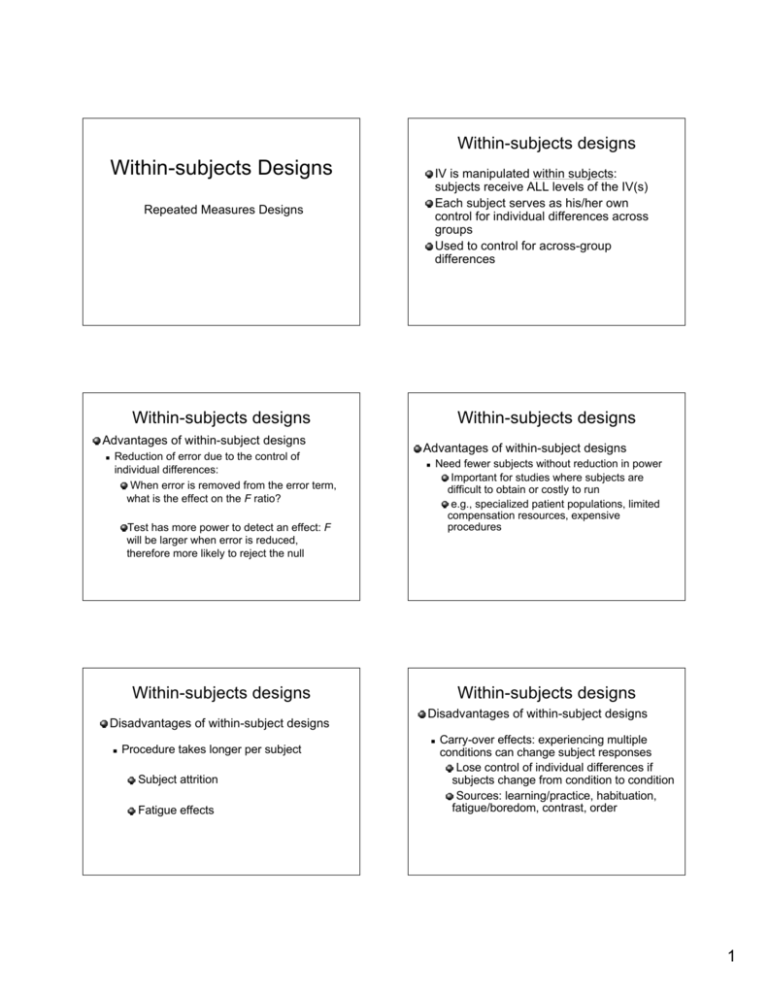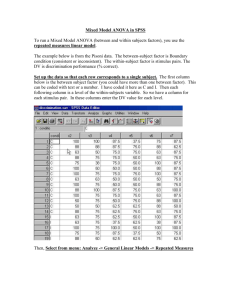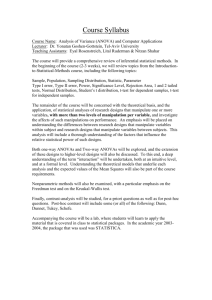Within-subjects Designs
advertisement

Within-subjects designs Within-subjects Designs IV is manipulated within subjects: subjects receive ALL levels of the IV(s) Each subject serves as his/her own control for individual differences across groups Used to control for across-group differences Repeated Measures Designs Within-subjects designs Advantages of within-subject designs Reduction of error due to the control of individual differences: When error is removed from the error term, what is the effect on the F ratio? Test has more power to detect an effect: F will be larger when error is reduced, therefore more likely to reject the null Within-subjects designs Advantages of within-subject designs Need fewer subjects without reduction in power Important for studies where subjects are difficult to obtain or costly to run e.g., specialized patient populations, limited compensation resources, expensive procedures Within-subjects designs Disadvantages of within-subject designs Procedure takes longer per subject Subject attrition Fatigue effects Within-subjects designs Disadvantages of within-subject designs Carry-over effects: experiencing multiple conditions can change subject responses Lose control of individual differences if subjects change from condition to condition Sources: learning/practice, habituation, fatigue/boredom, contrast, order 1 Within-subjects designs Disadvantages of within-subject designs Dealing with carry-over effects: counterbalancing Full: use all possible condition orders randomly assign subjects to one order Latin square design: number of orders = number of conditions randomly assign subjects to one order to spread order effect across all subjects Latin square designs Two types of designs: (1) Cyclic Latin square Example for 4 conditions: S1 S2 S3 S4 Latin square designs Two types of designs: (2) Diagram-balanced Latin square Example for 4 conditions: 1 2 3 4 S2 S3 S4 3 2 4 1 4 2 4 1 3 3 2 1 Counterbalancing can’t control ALL carry-over effects - some may remain (e.g., contrast effects; see p. 371 for examples) Can also test order as an IV (between-subjects) to MEASURE order effect 3 4 1 2 4 1 2 3 Two types of designs: Cyclic has the problem that a condition always follows the same condition (see diagrams) Diagram-balanced eliminates this problem However, both designs allow each condition to appear in each ordinal position exactly once Within-subject designs Dealing with carry-over effects: counterbalancing 2 3 4 1 Latin square designs S1 1 2 3 4 Within-subject designs Disadvantages of within-subject designs More restrictive test assumptions Sphericity – the variance of populations of difference scores are equal 2 Data Analyses with ANOVA Data Analyses with ANOVA Subjects are treated as a within-groups factor; SSBetween does not change, but SSWithin (error term) does change In within-subjects designs we use SSAxS as our error term (instead of SSS/A) because we have controlled for the SSS/A differences We are only concerned now with how the subjects within a group differ across groups (i.e., the subject by group interaction - how subject differences differ across groups) In between-subjects designs, error variance comes from individual differences + other kinds of error Data Analyses with ANOVA One-way within design One-way within-subjects design Analyzed as a two-way design with IV-A as one factor and subjects (S) as the other factor We can think of this as a full two-way design with marginal means for IV-A levels and levels of subjects (each individual) and consider deviations from the grand mean A1 A2 A3 S1 S2 S3 . . One-way within design You can test for the main effect of subjects (and SPSS will provide it), but it won’t be of interest in interpreting the results As with the between-subjects design, you will focus on the main effect of IV-A to look for causal effects One-way within design F ratio: MSA MSSxA The new error term will use error due to subject differences that are inconsistent across levels of A We’ve controlled for differences between a set of subjects across the levels by having subjects serve as their own control Now we focus on differences within groups that differ across A1, A2, etc. 3 One-way within design The result is that the error term SSSxA will be smaller than the SSS/A term we use with betweensubjects designs because we’ve removed some of the error that contributes to that term in between-Ss designs The result is a more powerful test of the IV-A effect due to a smaller denominator in the F ratio Example (Conceptual Formula) S1 S2 S3 S4 S5 S6 YA A1 8 8 9 0 13 10 8 A2 12 13 15 18 15 17 15 A3 9 14 6 12 18 7 11 YS 9.7 11.7 10.0 10.0 15.3 11.3 YT = 11.3 Example (Conceptual Formula) SSAxS = [(8-8-9.7+11.3)2 + (8-811.7+11.3)2 +…+ (7-11-11.3+11.3)2] = 156.7 dfAxS = (3-1)(6-1) = 10 MSAxS = 156.7 = 15.67 10 One-way within design Between-groups term MSA = nΣ(YA-YT)2 a-1 Within-groups (error) term MSSxA = Σ(YAS - YA -YS + YT)2 (a-1) (n-1) Example (Conceptual Formula) SSA = 6[(8-11.3)2 + (15-11.3)2 + (11-11.3)2] = 148.02 dfA = 3-1 = 2 MSA = 148.02 = 74.01 2 Example (Conceptual Formula) F = 74.01 = 4.72 vs. Fcrit(2,10) = 4.10 15.67 Significant effect of IV-A 4 Assumptions of Test Same assumptions as ANOVA for between-subjects: Normality Homogeneity of variance Plus new assumption Sphericity - differences between pairs of scores in population have same variance Assumptions of Test Sphericity Violations increase α Techniques exist to correct for violations SPSS will conduct a test for violation of assumption - just like it can test for homogeneity of variance assumption 5






